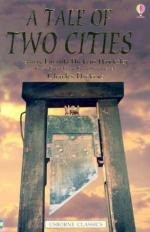|
This section contains 451 words (approx. 2 pages at 300 words per page) |

|
Foreshadowing in A Tale of Two Cities
Summary: Charles Dickens uses the literary device of foreshadowing in A Tale of Two Cities to move the plot forward. Examples cited include Madame Defarge's knitting, Gaspard's murder of the Marquis, and most significantly, the breaking of the wine case.
Throughout A TALE OF TWO CITIES, Charles Dickens uses foreshadowing to further the plot of the novel. Dickens foreshadows the plot in a number of ways. One example of foreshadowing within the novel is Madame Defarge's knitting. Madame Defarge`s knitting foreshadows the upcoming revolution, in that she is knitting a register of people that she believes must be killed. Also, her knitting foreshadows the imprisonment of Charles Darnay, as well as the violence that will soon come.
In addition to the foreshadowing of Madame Defarge's knitting, Charles Dickens also foreshadows the revolution through the scenes involving the Marquis and Gaspard. After the Marquis carelessly kills Gaspard's child, Gaspard seeks revenge on the Marquis, by killing him. This event foreshadows the revolution in that Gaspard, symbolizing the lower class, revolts against the Marquis, representing the upper classes. The murder of the Marquis foreshadows the lower class revolting against...
|
This section contains 451 words (approx. 2 pages at 300 words per page) |

|


